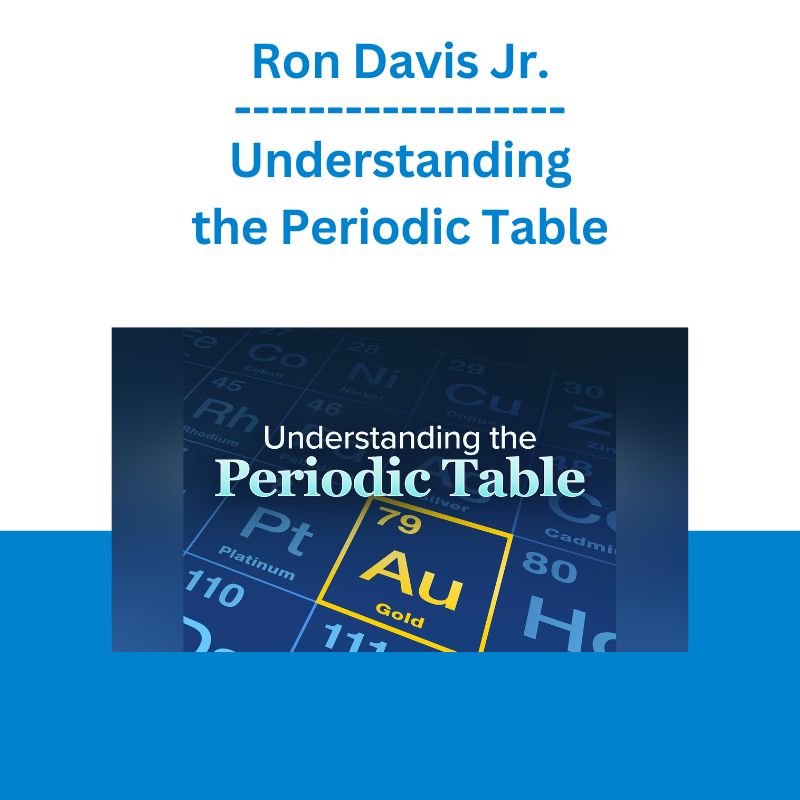*** Proof of Product ***
Exploring the Essential Features of “Ron Davis Jr. – Understanding the Periodic Table”
Understanding the Periodic Table
Explore the periodic table from arsenic to zinc and everything in between.
LECTURE
Trailer
01:The Periodic Table: Our Menu of Matter
Human beings have interacted with elements since prehistoric times. Yet large-scale efforts to organize these elements did not come about until the 19th century. In this lesson, become ac-quainted with the periodic table. Learn about its basic organizing principles and allow Ron to take you on a quick tour of its evolution through time.
31 min
02:From Triads to Tables and the Role of Protons
The periodic table was a collaborative effort that spanned centuries. In this lesson, dig deeper into its early history. Learn about debates surrounding the classification and categorization of elements, and explore how the discovery of subatomic particles, specifically protons, propelled a specific version of the periodic table to the forefront.
29 min
03:How Electrons Shape the Table
What gives the modern periodic table its distinctive shape? The answer: electrons. Understand the relationship between an atom’s nucleus and its electrons, then discover how these peculiar subatomic particles—that do not always behave like particles—determine the number and type of bonds an element can make.
31 min
04:Periodic Trends in Element Properties
What constitutes a “group” of elements? Are neighboring groups similar in some way? And be-yond proton counts and electron valences, what other chemical and physical characteristics govern the structure of the periodic table? Better understand how the periodic table brings to-gether elements with similar properties from the size of their atomic radius to their electro-negativity.
29 min
05:The Origin and Distribution of the Elements
Here, grasp how just three elements—hydrogen, helium, and lithium—combined to create new, heavier elements like uranium or sulfur through the complicated process of nuclear fu-sion. Also discover how natural and cosmic events like supernovas can lead to the creation of new elements through time.
30 min
06:Elements Break Down: Radiation and Fission
A cosmic event is not the only way an element can transform. The processes of transmutation, radiation, and nuclear fission are equally capable of radically altering elements and their be-haviors. Familiarize yourself with the ever-important process of transmutation and learn how elements with unstable nuclei break down to produce more stable products through radiation and nuclear fission.
30 min
07:First-Row Opposites: Hydrogen and Helium
Shifting gears, spend some time on the first and smallest row of the periodic table. Consider some important questions: What do two of the oldest, lightest elements—hydrogen and heli-um—have in common? How do they differ? And would they make sense somewhere else on the periodic table, given their particular characteristics and behaviors?
32 min
08:Sodium, Potassium, and the Alkali Metals
Despite the abundance of lithium, sodium, potassium, rubidium, and cesium in the environ-ment, researchers did not isolate alkali metals until the 1800s. Here, focus on the elusive ele-ments that make up the first column and major group of the periodic table and understand what led to their discovery and why they are so quick to combine with other elements.
33 min
09:Magnesium, Calcium, and the Alkaline Earths
After the alkali metals come the alkaline metals, a slightly less reactive group of elements. In this lesson, explore the characteristics of group two metals like calcium, strontium, and barium, and figure out why they oxidize slower and melt at higher temperatures than the alkali metals.
32 min
10:Enormous Variety on the Table’s Right Side
What exactly stitches the p-block of the periodic table together? In this lesson, get acquainted with the metals, metalloids, and nonmetals of the p-block, a collection of diverse elements that stretches from row two to seven of the periodic table. Take a detailed walk through the chemi-cal and physical characteristics, distinguishing behaviors, and common uses of p-block ele-ments.
33 min
11:Noble Gases: The “Lazy” Unreactive Elements
Discovered in the 19th century, noble gasses stupefied chemists; these elements react poorly with themselves and other chemicals and, for that reason, remain remarkably stable in their environments. Explore the history behind noble gasses starting with Argon, understand the con-ditions and methods that led to their discovery, and become familiar with the basic properties and behaviors of these unique gaseous elements.
30 min
12:Halogens: The Most Reactive Nonmetals
Group 17 contains some of the most reactive elements on the periodic table. As you explore this group, become familiar with the halogens, a group of elements quick to combine with met-als to form salts. Learn about each element in the group from most reactive to least and ex-plore the unique set of properties that define each halogen on the table.
30 min
13:Why Oxygen and Nitrogen Are Irreplaceable
Among a sea of 118 elements, many of them novel and poorly understood, oxygen and nitrogen stand out because they are familiar to us. But what do we really know about their discovery, behaviors, and subatomic structures? And what can the periodic table reveal about their abun-dance in Earth’s atmosphere? Answer these questions and more.
34 min
14:Complexity of Carbon, Sulfur, and Phosphorus
In the final set of nonmetal elements on the periodic table, diversity abounds. These elements do not behave like most nonmetals in that some can conduct electricity, form solids under standard conditions, and can exhibit a range of allotropes. Spend this lesson exploring the suba-tomic peculiarities and behaviors of carbon, phosphorus, sulfur, and selenium.
33 min
15:Silicon and the Metalloid Diagonal
Between the metal and nonmetal groups, you will find a third and more peculiar group: the metalloids. What specific properties—subatomic and beyond—do they share with metals, and how do they behave like nonmetals? Unearth the history behind the discovery of metalloids and learn why they are so useful when they combine with other elements.
31 min
16:Aluminum, Tin, Lead, and Other Weak Metals
p-Block metals are faced with an identity crisis as they behave like metals and nonmetals at the same time. But why is this the case? Get to know the “weak” metals and why they behave the way they do. Understand how the electron configurations of elements like gallium and lead af-fect their behavior, discover what sets p-block elements apart from the metals of the d-block, and more.
31 min
17:The Table’s Great Divide: Transition Metals
The valley at the middle of the periodic table features one-third of naturally occurring ele-ments—all of which are metals. What do they have in common and what sets them apart? Take an introductory tour of the d-block metals from the poisonous to the ultra-dense before spend-ing the next few lessons exploring three groups of transition metals in detail.
31 min
18:Colorful and Durable Early Transition Metals
What makes precious gemstones so colorful? The answer: a group of metals from the d-block of the periodic table. Begin with a focus on the early transition metals of the d-block. From vana-dium to rhenium, consider the distinct geometries of their subshells, walk through their every-day uses, and understand the complexities of their oxidation states.
30 min
19:Magnets and Catalysts of the Middle Transition
Iron is Earth’s most abundant element while platinum and other noble metals are among its most stable. Learn about the history, fundamentals, and uses of the periodic table’s precious metals. Move from the iron triad to the platinum group of elements and discover how this set of d-block “noble” metals changed the way we fuel the world’s automobiles.
29 min
20:From Coins to Toxins: Copper to Mercury
Coinage metals look like other group VIII elements, but they also possess some properties rem-iniscent of alkali and alkaline metals. In this lesson, complete the d-block by delving into cop-per, silver, gold, zinc, cadmium and mercury. Explore the special subatomic qualities that made these metals so hard to categorize and discover what they are typically used for.
29 min
21:Rare-Earth Elements: Surprisingly Abundant
It may be surprising that rare-earth elements are not all that uncommon compared to other elements on the periodic table. Instead, their most distinctive feature is a common geochemis-try. Here, focus on how rare-earth elements and the so-called “lanthanide contraction” trend spurred substantial technological advancements in lighting, electronics, headphones, and more.
31 min
22:Nuclear Fuel: Thorium, Uranium, and Plutonium
At the very bottom of the periodic table, you will find some of its most radioactive and unstable elements. Now, turn to the seventh row and spend some time with the most abundant pair of “light” actinoids—uranium and thorium—and learn how instability and radioactive decay have come to define this group of elements.
30 min
23:Creating the Transplutonic Elements
The discovery of the neutron in 1932 was a germinal event in the history of science. Soon after, scientists discovered how the combination of neutrons and naturally occurring elements can create new elements that cannot and do not exist in nature. Continue your exploration of the bottom of the table by focusing on the finding, features, and functions of the transplutonic ele-ments.
30 min
24:Superheavy Atoms and the Transfermium Wars
In this lesson, turn to the very end of the periodic table and delve into the so-called “superheavy” elements. Learn about the contentious Cold War history behind row seven of the periodic table and how the quest to complete the table moved from politically fraught to inter-nationally collaborative.
34 min
DETAILS
Overview
Understanding the Periodic Table couples a comprehensive overview of the periodic table with in-depth lessons on each of its 118 elements. With Ron Davis Jr. of Georgetown University as your expert guide, you will be able to refine your portrait of one of science’s most iconic images and crucial organizational tools in 24 lessons that combine instructions with experiments and animated lab demonstrations. Spend the first half of the course exploring the history and fundamentals of the periodic table. In part two, move from the top to bottom row to explore the discoveries, subatomic structures, behaviors, and everyday uses of the table’s elements in striking detail.
About
Ron B. Davis Jr.
I hope this contributes to a lifelong journey exploring and appreciating the rich and beautiful chemistry of life and our world.
Dr. Ron B. Davis, Jr. is an Associate Teaching Professor of Chemistry at Georgetown University, where he has been teaching introductory organic chemistry laboratories since 2008. He earned his Ph.D. in Chemistry from The Pennsylvania State University. Prior to teaching chemistry at the undergraduate level, Professor Davis spent several years as a pharmaceutical research and development chemist. Professor Davis’s research focuses on the fundamental forces governing the interactions of proteins with small organic molecules. His research has been published in such scholarly journals as Proteins and Biochemistry and has been presented at the Annual Symposium of The Protein Society. He also maintains an educational YouTube channel and provides interviews and content to various media outlets, including The Discovery Channel. At The Pennsylvania State University, Professor Davis received a Dalalian Fellowship and the Dan Waugh Teaching Award. He is also a member of the Division of Chemical Education of the American Chemical Society.
REVIEWS
Karl Schiner
One of the best teachers
Dr. Davis has the gift of teaching. He is able to graphically illustrate and elucidate some difficult concepts. He is a model of an ideal professor.
Dr GDB
Excellent presentation
Excellent speaker and clearly presented A pleasure to learn from
Please see the full list of alternative group-buy courses available here: https://lunacourse.com/shop/









